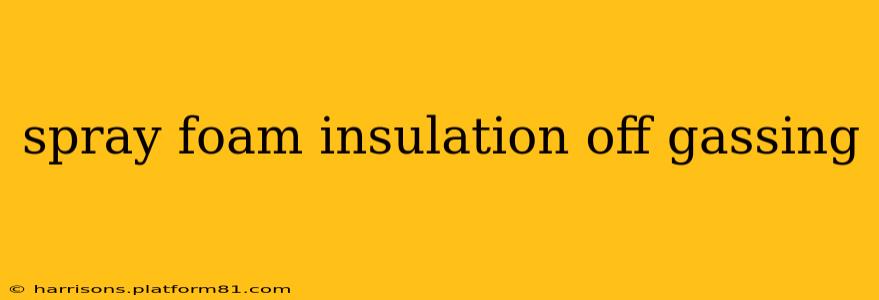Spray foam insulation, while offering excellent energy efficiency and air sealing capabilities, has raised concerns regarding off-gassing. This refers to the release of volatile organic compounds (VOCs) after installation. Understanding the types of VOCs released, their potential health effects, and mitigation strategies is crucial for homeowners and installers alike. This comprehensive guide will address common questions and concerns surrounding spray foam insulation off-gassing.
What VOCs are Released from Spray Foam Insulation?
Spray foam insulation, particularly open-cell varieties, can release various VOCs, including isocyanates, diphenylmethane diisocyanate (MDI), toluene diisocyanate (TDI), and various solvents. The specific VOCs and their concentrations depend heavily on the type of spray foam used (open-cell vs. closed-cell), the manufacturer's formulation, and the application process. Closed-cell spray foam generally releases fewer VOCs than open-cell foam. It's important to note that the levels of VOC emission are regulated and manufacturers provide data sheets detailing the emission rates.
How Long Does Spray Foam Insulation Off-Gas?
The off-gassing process is not instantaneous. It can take weeks, months, or even years for the VOC emissions to significantly decrease, depending on several factors. These factors include the type of foam, the amount of foam installed, the temperature and humidity levels in the space, and the level of ventilation. While the initial off-gassing is typically the most intense, a low-level release can persist for a considerable period.
Is Spray Foam Insulation Safe?
The safety of spray foam insulation is a subject of ongoing discussion. When properly installed and using low-VOC or zero-VOC formulations, the risks are generally considered minimal for most individuals. However, individuals with pre-existing respiratory conditions or sensitivities to chemicals should exercise caution and potentially consult with their healthcare provider before having spray foam insulation installed. Always choose reputable installers who understand proper ventilation and safety protocols.
What are the health effects of spray foam off-gassing?
Exposure to high concentrations of VOCs from spray foam can lead to various short-term and long-term health problems. Short-term effects can include eye, nose, and throat irritation, headaches, dizziness, and nausea. Long-term exposure to high levels of certain VOCs has been linked to more serious health concerns, though the scientific consensus on the extent of these risks varies depending on the specific VOCs and the level of exposure. Proper ventilation significantly mitigates these risks.
How can I reduce the off-gassing of spray foam insulation?
Several steps can be taken to minimize off-gassing. Choosing low-VOC or zero-VOC spray foam is the most effective method. Adequate ventilation during and after installation is critical to quickly remove VOCs from the building. This can involve the use of exhaust fans, opening windows, and ensuring proper air circulation. Post-installation air quality testing can provide assurance that VOC levels are within acceptable ranges.
What are the benefits of low-VOC spray foam insulation?
Low-VOC and zero-VOC spray foam insulation provides the same excellent insulation properties as standard spray foam, but with significantly reduced VOC emissions. This lowers the risk of health problems associated with off-gassing and contributes to a healthier indoor environment. While often slightly more expensive, the long-term health benefits frequently outweigh the initial cost difference.
Is there a way to test for VOCs after spray foam insulation installation?
Yes, professional air quality testing can measure the concentration of various VOCs in your home after spray foam insulation installation. This provides quantitative data to assess whether levels are within safe limits and helps ensure the safety and well-being of occupants.
What are the regulations surrounding VOC emissions from spray foam insulation?
Many regions have regulations regarding the allowable VOC levels in building materials, including spray foam insulation. These regulations vary by location, but they aim to protect public health and ensure responsible manufacturing practices. It is crucial to check your local building codes and environmental regulations.
By understanding the potential for off-gassing and taking proactive steps to mitigate its effects, homeowners can enjoy the benefits of spray foam insulation while maintaining a healthy indoor environment. Always prioritize reputable installers, low-VOC materials, and adequate ventilation.
